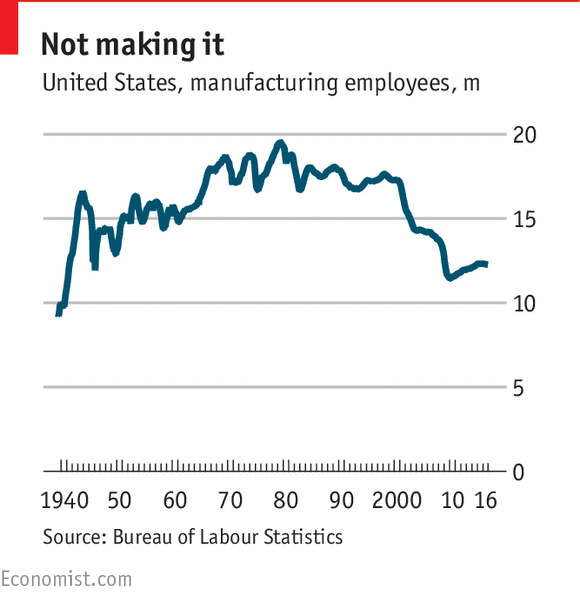INDUSTRIAL policy via Twitter is a new development in economics but we may all have to get used to it over the next four (or eight) years. Donald Trump’s tweets on the car industry (and his planned cuts to corporate income tax) may or may not have persuaded Ford to keep a plant in Michigan, creating 700 jobs. But the problem with such headline-grabbing is that there are thousands of companies in America, and jobs are being created or destroyed every day; intervening in all these situations is impossible. Even in cars, for example, GM has recently announced 3,300 lay-offs , almost five times greater than the Ford additions.
History suggests that the aim of creating large numbers of manufacturing jobs will be a lost cause.
In 1979, the high point for American manufacturing jobs was reached at 19.5m. The subsequent recession of the early 1980s caused that number to fall but there were regularly 17m-18m jobs in the 1980s and 1990s. From the turn of the millennium, however, the total fell pretty remorselessly, with the 2008-09 recession proving the coup de grace. The low was just under 11.5m in early 2010. As the economy recovered, some jobs returned and a peak of 12.3m was reached early last year. But since then, the numbers have been drifting down again

The same kind of declines have been seen across the developed world, indicating that this is not a particular problem of American economic policy. A report from the Congressional Research Service sets the context; America’s share of global manufacturing value added fell 12 percentage points between 1993 and 2014 but Japan’s share fell 14 points over the same period.
Unsurprisingly, China has taken the bulk of the market share.
In terms of employment, the 31% decline in America between 1990 and 2014 compared with a 25% fall in Germany, 33% declines in France and Sweden, 34% in Japan and 49% in the UK.
The problem is not just China but technology.
Industries, like cars and steel, tend to be plagued by overcapacity. There can be good times in the cycle (American car sales are setting new records, for example). The 2008-09 slump caused people to postpone their purchases but eventually confidence recovered; cars wear out and must be replaced. But a downturn will inevitably come;research suggest that consumers’ budgets are stretched, leading them to finance today’s car buys over six to seven years, delaying the next car purchase. A competitive market means that car manufacturers must keep investing to add new features while keeping prices down; that may mean replacing people with machines. It also means that a lot of the value added in a car comes from the software that runs it; jobs that tend to go to college graduates or are not found in rustbelt states. In Britain, the share of low-skilled manufacturing jobs has fallen since the 2008 recession while foreign-born workers comprise 17% of the total, similar to banking. The service sector contributes more than 30% of value added in American manufacturing and more than 40% in France and Italy.
And herein lies the problem of focusing on manufacturing jobs which comprise just 10% of all employment in America (in percentage terms, there has been a virtually uninterrupted . Slapping on tariffs to punish manufacturers who export jobs makes little sense in a world of global value chains, every dollar of Mexican goods exported to America contains 40 cents of American goods embedded within it. Worse still, the disruption to trade in services that might result, let alone the higher prices that consumers would have to pay, would far outweigh the positive impact of keeping a few jobs in America.
The markets seem remarkably sanguine about all this; far more so than they would have done if a President Bernie Sanders were threatening American businesses with retaliation. But we have seen individual stocks take a hit (Boeing , for example) when they came into the Twitter firing line of Mr Trump. Eventually, one thinks, the unpredictability of the attacks will wear out investors’ nerves.


